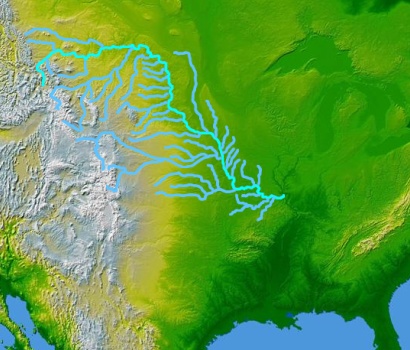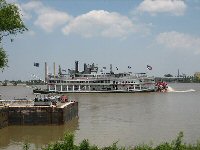Things to Know
The Missouri River is the longest river in North America. The Missouri River is about 2,341 miles (3,767 km) long.
It flows from its headwaters at the confluence of the Madison, Jefferson, and Gallatin rivers in the Rocky Mountains at Three Forks, Montana and flows south and east into the Mississippi at St. Louis, Missouri.
 The Missouri River in green,
The Missouri River in green,
and its tributaries in blue
The Missouri River drains nearly one sixth of the area of the United States with a drainage area of 529,350 square miles. The terrain in the basin ranges from the eastern slope of the Rocky Mountains to the fertile soils of the central prairies.
The basin is home to about 10 million people from 28 Native American tribes, 10 states (Colorado, Iowa, Kansas, Minnesota, Missouri, Montana, Nebraska, North Dakota, South Dakota, Wyoming), and a small part of Canada.
The Missouri River is the most changed river in the USA. It was tamed to control the floods that occured with destructive force. Its many dams and reservoirs have created many lakes. In the upper one-third of the Missouri river has been changed into lake environments with the building of six large dams in Montana, North Dakota, South Dakota, and Nebraska, the lower one-third is channeled which has eliminated sandbars, and one-third is free flowing stretches of water. Only one percent of the Missouri River remains uncontrolled by humans.
The nicknames of the Missouri are "Big Muddy" and "Muddy Mo" (abbreviation for Missouri is MO), because it has a lot of silt.
The first Europeans to see the Missouri River were French explorers Father Jacques Marquette and Louis Jolliet in 1683. Canadian explorer
Pierre Gaultier de la Verendrye and his sons explored the upper reaches of the Missouri River in 1742.
They buried a lead plate in the area of Pierre and Fort Pierre, South Dakota as the basis for French sovereignty of the upper Missouri. School children playing on the hill found the lead plate in 1913.
Meriwether Lewis and William Clark travelled the length Missouri on their journey (1803–1806) to the Pacific Ocean with the Corps of Discovery.
The first steamboat traveled up the Missouri River in 1819, and hundreds more later navigated the uncertain waters.
Today, the river is used primarily for commerce with some river cruises.
333333333333

Steamboat Natchez, one of the last of
the old paddle-wheelers on the lower
Mississippi
The Mississippi River supples drinking water for about 18 million people. It also supples water to farms for crops and factories. About 50 cities relay on the Mississippi River for their daily water. The river provides freshwater for many species of plants and animals.
Steamboats
Read a short history of steamboats.
Steamboat color page
Mississippi Steamboat Model
Print and assembly (hard)
Mississippi River of Song (pbs)
River Rat Quiz
Take the online quiz.
The All-Star River Explorers
Discover the basics of rivers and how they are formed.
Mississippi-National River and Recreation Area
Photos and Multimedia
The Mighty Mississippi River Lesson (grades 3+)
A printable reading comprehension lesson.
Mark Twain official website
Mark Twain Boyhood Home and Museum
Many of Mark Twain’s famous stories are related to or take place near the Mississippi River.